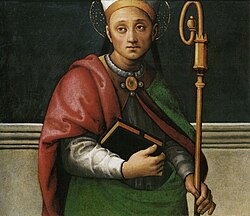Pope Agapetus I was the bishop of Rome from 13 May 535 to his death. His father, Gordianus, was a priest in Rome and he may have been related to two previous popes, Felix III and Gregory I.
The 540s decade ran from January 1, 540, to December 31, 549.

Year 549 (DXLIX) was a common year starting on Friday of the Julian calendar. The denomination 549 for this year has been used since the early medieval period, when the Anno Domini calendar era became the prevalent method in Europe for naming years.

Pope Gregory I, commonly known as Saint Gregory the Great, was the bishop of Rome from 3 September 590 to his death. He is known for instigating the first recorded large-scale mission from Rome, the Gregorian mission, to convert the then largely pagan Anglo-Saxons to Christianity. Gregory is also well known for his writings, which were more prolific than those of any of his predecessors as pope. The epithet Saint Gregory the Dialogist has been attached to him in Eastern Christianity because of his Dialogues. English translations of Eastern texts sometimes list him as Gregory "Dialogos", or the Anglo-Latinate equivalent "Dialogus".
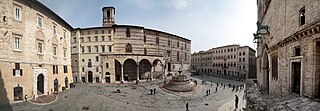
Perugia is the capital city of Umbria in central Italy, crossed by the River Tiber, and of the province of Perugia. The city is located about 164 km (102 mi) north of Rome and 148 km (92 mi) southeast of Florence. It covers a high hilltop and part of the valleys around the area. The region of Umbria is bordered by Tuscany, Lazio, and Marche.
Pope Pelagius I was the bishop of Rome from 556 to his death. A former apocrisiarius to Constantinople, Pelagius I was elected pope as the candidate of Emperor Justinian I, a designation not well received in the Western Church. Before his papacy, he opposed Justinian's efforts to condemn the "Three Chapters" in order to reconcile theological factions within the Church, but later adopted Justinian's position.

Totila, original name Baduila, was the penultimate King of the Ostrogoths, reigning from 541 to 552 AD. A skilled military and political leader, Totila reversed the tide of the Gothic War, recovering by 543 almost all the territories in Italy that the Eastern Roman Empire had captured from his Kingdom in 540.

Benedetto Bonfigli was an Italian Renaissance painter born in Perugia, and part of the Umbria school of painters including Raphael and Perugino. He is also known as Buonfiglio. Influenced by the style of Domenico Veneziano, Benozzo Gozzoli, and Fra Angelico, Bonfigli primarily painted frescos for the church and was at one point employed in the Vatican. His best preserved work is the Annunication, but his masterpiece is the decoration of the chapel of the Palazzo dei Priori. Bonfigli specialized in gonfaloni, a Perugian style using banners painted on canvas or linen. Little is known of his personal life, but he was an esteemed painter in Perugia before Perugino, who is said to be his pupil.
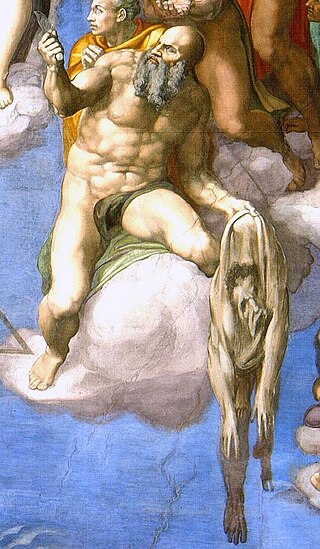
Flaying, also known colloquially as skinning, is a method of slow and painful execution in which skin is removed from the body. Generally, an attempt is made to keep the removed portion of skin intact.
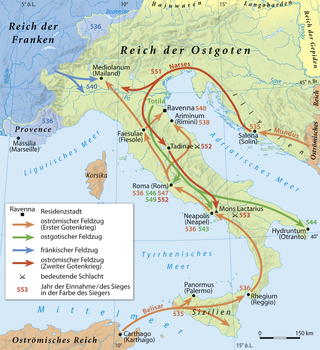
The Gothic War between the Eastern Roman Empire during the reign of Emperor Justinian I and the Ostrogothic Kingdom of Italy took place from 535 to 554 in the Italian Peninsula, Dalmatia, Sardinia, Sicily and Corsica. It was one of the last of the many Gothic Wars against the Roman Empire. The war had its roots in the ambition of the Eastern Roman (Byzantine) Emperor Justinian I to recover the provinces of the former Western Roman Empire, which the Romans had lost to invading barbarian tribes in the previous century, during the Migration Period.

November 6 - Eastern Orthodox liturgical calendar - November 8

February 28 - Eastern Orthodox liturgical calendar - March 2

Constantius of Perugia is one of the patron saints of Perugia, Italy.

Perugia Cathedral is a Roman Catholic cathedral in Perugia, Umbria, central Italy, dedicated to Saint Lawrence. Formerly the seat of the bishops and archbishops of Perugia, it has been since 1986 the archiepiscopal seat of the Archdiocese of Perugia-Città della Pieve.
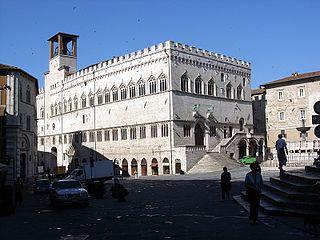
The Palazzo dei Priori or comunale is one of the best examples in Italy of a public palace from the communal era. It is located in the central Piazza IV Novembre in Perugia, Umbria. It extends along Corso Vannucci up to Via Boncambi. It still houses part of the municipality, and, on the third floor, the Galleria Nazionale dell'Umbria. It takes its name from the Priori, the highest political authority governing the city in the medieval era.
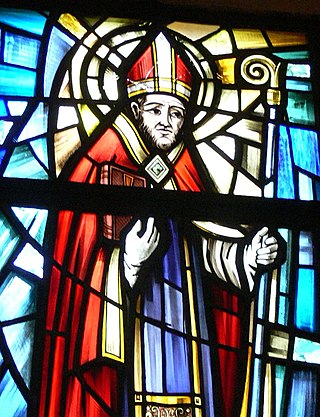
Saint Cerbonius was a bishop of Populonia during the Barbarian invasions. Saint Gregory the Great praises him in Book XI of his Dialogues.

The Sack ofRome in 546 was carried out by the Gothic king Totila during the Gothic War of 535–554 between the Ostrogoths and the Eastern Roman Empire. Totila was based at Tivoli and, in pursuit of his quest to reconquer the region of Latium, he moved against Rome. The city endured a siege lasting almost a year before falling to the Goths.

Perugia was a long-time papal residence during the 13th century. Five popes were elected here: Pope Honorius III (1216–1227), Pope Clement IV (1265–1268), Pope Honorius IV (1285–1287), Pope Celestine V (1294), and Pope Clement V (1305–1314). These elections took place in the Palazzo delle Canoniche adjoining the Perugia Cathedral.

The city of Rome was besieged in AD 549–550 by the Ostrogoths, led by Totila, during a campaign to recapture Italy from the Byzantine Empire. After Totila imposed a blockade, soldiers from the city's garrison opened the gates to him. Many of the male inhabitants were killed in the city or while attempting to flee. The city was afterwards repopulated and rebuilt.
Odolgan was a Hun commander serving under the Byzantine Empire. He was the commander of the garrison of Perugia.
